|
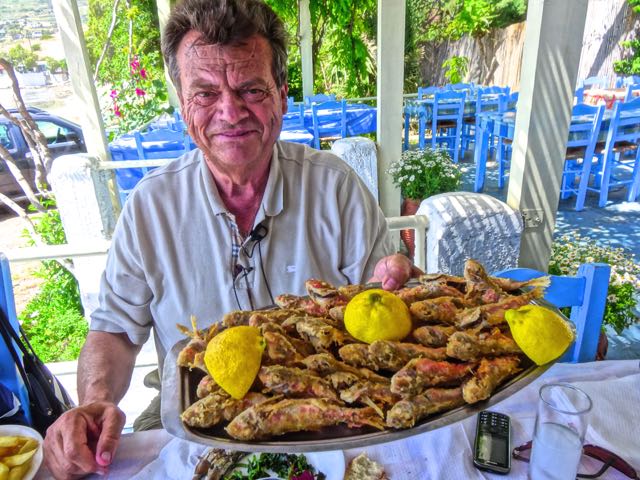 If you take a look at a map of Greece you will see why fish is such an important part of the Greek diet. For such a small country there is a lot of coastline which is why they have a strong history of seafaring. Eating seafood goes along with that. Unfortunately the sea which was once so abundant
is now barren in places because of over-fishing and the Aegean sea simply can't keep up with the demand of a seafood-loving population whose numbers swell during the tourist
season. Fish can be very expensive, though there are inexpensive fish available year-round, and these are just as tasty as the expensive ones. Let us start at the bottom and make our way up the fish chain going from the cheapest to the most expensive and hopefully after reading this article you will be able to have a nice fish dinner in Greece without spending more than you spent on your flight to Greece. Incidently speaking of flights to Greece, the first thing I do when I get off the plane is have George
the Famous Taxi Driver take me to the sea for a swim and a fish lunch (photo). If you take a look at a map of Greece you will see why fish is such an important part of the Greek diet. For such a small country there is a lot of coastline which is why they have a strong history of seafaring. Eating seafood goes along with that. Unfortunately the sea which was once so abundant
is now barren in places because of over-fishing and the Aegean sea simply can't keep up with the demand of a seafood-loving population whose numbers swell during the tourist
season. Fish can be very expensive, though there are inexpensive fish available year-round, and these are just as tasty as the expensive ones. Let us start at the bottom and make our way up the fish chain going from the cheapest to the most expensive and hopefully after reading this article you will be able to have a nice fish dinner in Greece without spending more than you spent on your flight to Greece. Incidently speaking of flights to Greece, the first thing I do when I get off the plane is have George
the Famous Taxi Driver take me to the sea for a swim and a fish lunch (photo).
|
|
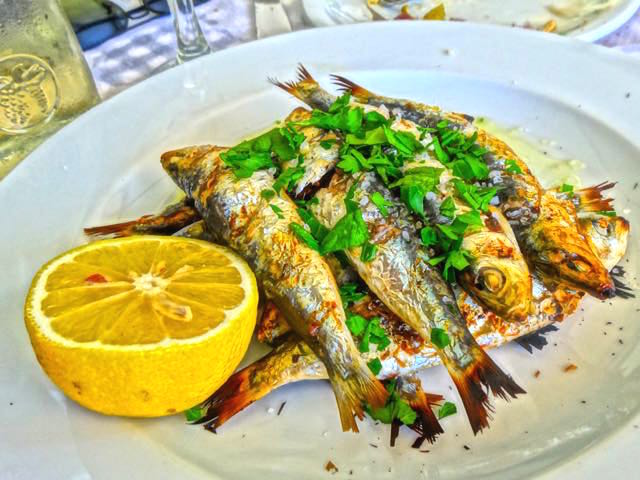 The cheapest fish are sardeles (sardines), gavros (anchovies), kolios (mackerel), gopa (bogue) and marides (smelt). Also in this inexpensive category are kalamari (squid), though only the frozen variety which is usually, if not always, imported from California,
China and other far away places. When kalamari is in season they will tell you on the menu that it is fresh. When cut and fried it is usually frozen but fresh kalamari is grilled or fried whole. In the kalamari family is also thrapsala which to you and I looks like a squid and tastes like a squid but is not a squid. Well maybe it is a squid but they call it thrapsala and like fresh kalamari they serve it grilled or fried whole. In the same family are soupia (cuttlefish) which
have
shorter
tentacles and are never fried but cooked in a stew with tomato sauce. Octopus, which is eaten in small amounts as a meze (snack) can be local or can come from China or the Atlantic. Octopus can be served in a number of ways which I will go into later. In between there are a number of fish whose price depends on supply and include xifia (sword fish), a couple varieties of Mediterranean tuna, and a whole family of bream, trout and even mollusks. Included among them is fagri (red porgy), sargos
(sea-bream), lavraki (sea bass), lithrini (pandora), and synagrida (dentex) most of which are either baked or grilled and sold by the kilo. More and more fish are now farmed so if you have a problem with that be sure to ask at the restaurant. The most likely fish to be from a farm are sargos
(sea-bream) and lavraki (sea bass), which Greece is the number 1 country in the EU and number 3 in the world for production. The cheapest fish are sardeles (sardines), gavros (anchovies), kolios (mackerel), gopa (bogue) and marides (smelt). Also in this inexpensive category are kalamari (squid), though only the frozen variety which is usually, if not always, imported from California,
China and other far away places. When kalamari is in season they will tell you on the menu that it is fresh. When cut and fried it is usually frozen but fresh kalamari is grilled or fried whole. In the kalamari family is also thrapsala which to you and I looks like a squid and tastes like a squid but is not a squid. Well maybe it is a squid but they call it thrapsala and like fresh kalamari they serve it grilled or fried whole. In the same family are soupia (cuttlefish) which
have
shorter
tentacles and are never fried but cooked in a stew with tomato sauce. Octopus, which is eaten in small amounts as a meze (snack) can be local or can come from China or the Atlantic. Octopus can be served in a number of ways which I will go into later. In between there are a number of fish whose price depends on supply and include xifia (sword fish), a couple varieties of Mediterranean tuna, and a whole family of bream, trout and even mollusks. Included among them is fagri (red porgy), sargos
(sea-bream), lavraki (sea bass), lithrini (pandora), and synagrida (dentex) most of which are either baked or grilled and sold by the kilo. More and more fish are now farmed so if you have a problem with that be sure to ask at the restaurant. The most likely fish to be from a farm are sargos
(sea-bream) and lavraki (sea bass), which Greece is the number 1 country in the EU and number 3 in the world for production.
|
|
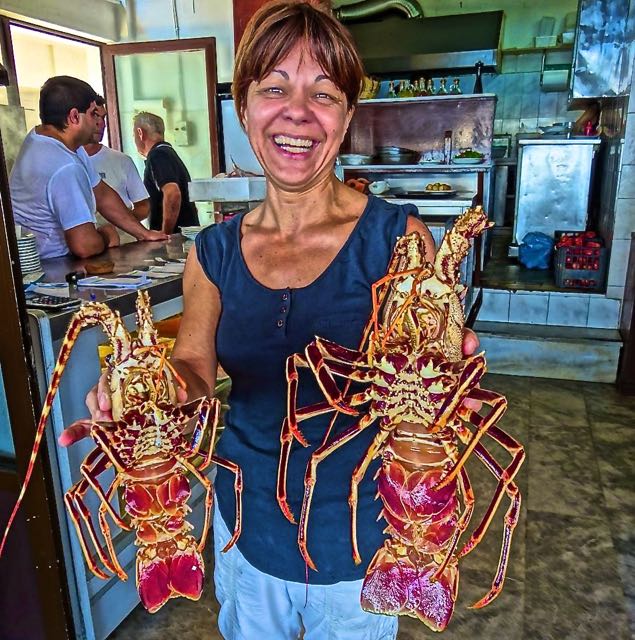 Then at the top of the fish food chain is astakos (lobster), which can cost a small fortune and is familiar to anyone who has taken a charter sailboat around the islands because many skippers take their clients to the tavernas that serve fresh lobster or the newly popular astako makaronada (macaroni with lobster). Not surprising
since skippers
often get a commission from the restaurants for any business they bring and a table full of lobster can cost a few hundred euros or more. But here's a tip. Save your lobster-money for home. Mediterranean lobsters are over-rated, under-tasty and few chefs have mastered the cooking of these creatures. They also lack claws which besides the tails are the only edible part unless you want to spend the night sucking bits of meat from legs and antennae. (Yes. The Greek lobsters have meat in the antennae! But not enough
to justify eating them.) In Milos I did see lobsters with claws at the restaurant of the famous Roberto at Da Peppe. "Where did you find lobsters with claws?" I asked him in wonder. "On the airplane" he said in his broken English. They were flown in, maybe from Maine, definitely from somewhere on the Atlantic. Then at the top of the fish food chain is astakos (lobster), which can cost a small fortune and is familiar to anyone who has taken a charter sailboat around the islands because many skippers take their clients to the tavernas that serve fresh lobster or the newly popular astako makaronada (macaroni with lobster). Not surprising
since skippers
often get a commission from the restaurants for any business they bring and a table full of lobster can cost a few hundred euros or more. But here's a tip. Save your lobster-money for home. Mediterranean lobsters are over-rated, under-tasty and few chefs have mastered the cooking of these creatures. They also lack claws which besides the tails are the only edible part unless you want to spend the night sucking bits of meat from legs and antennae. (Yes. The Greek lobsters have meat in the antennae! But not enough
to justify eating them.) In Milos I did see lobsters with claws at the restaurant of the famous Roberto at Da Peppe. "Where did you find lobsters with claws?" I asked him in wonder. "On the airplane" he said in his broken English. They were flown in, maybe from Maine, definitely from somewhere on the Atlantic.
|
|
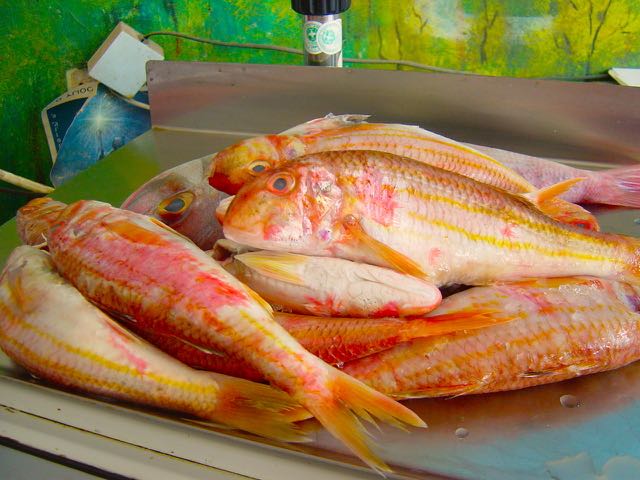 So while you are allowing the lobsters of Greece to re-establish themselves and maybe grow some claws, what can someone who wants to spend a lot of money on fish buy that is worth the expense. I have one word. Barbounia. The red-mullet is the best tasting fish you will ever eat, whether fried or grilled.
Is it worth 55 euros a kilo? Well, luckily
you can't eat a kilo. Half a kilo is enough for two and though you may want more after the last morsel of fish, skin or even bone is eaten, chances are there will be other fish on the table too. For those who think 55 euros is a little steep there are koutsomoures, the paler cousins of the barbouni, which some people like better and are cheaper. By the way just for the record I prefer barbounia and koutsomoura fried and if you order it this way there should not be much of a fish left
when you are finished. Usually the only thing left on my plate is the backbone. So while you are allowing the lobsters of Greece to re-establish themselves and maybe grow some claws, what can someone who wants to spend a lot of money on fish buy that is worth the expense. I have one word. Barbounia. The red-mullet is the best tasting fish you will ever eat, whether fried or grilled.
Is it worth 55 euros a kilo? Well, luckily
you can't eat a kilo. Half a kilo is enough for two and though you may want more after the last morsel of fish, skin or even bone is eaten, chances are there will be other fish on the table too. For those who think 55 euros is a little steep there are koutsomoures, the paler cousins of the barbouni, which some people like better and are cheaper. By the way just for the record I prefer barbounia and koutsomoura fried and if you order it this way there should not be much of a fish left
when you are finished. Usually the only thing left on my plate is the backbone.
|
|
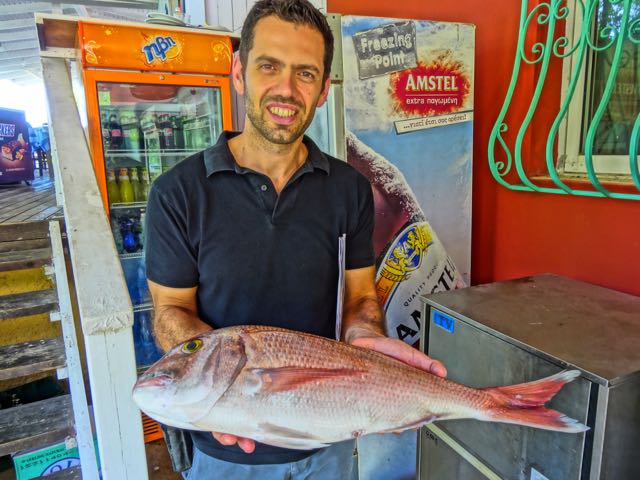 Going out for a fish dinner is always a fun time if you are with someone who knows what they are doing. Usually the fish restaurants are on the sea, outside of Athens. One of my favorite areas is Anavissos, on the way to Sounion, a small seaside town famous for its fish tavernas. There are waiters standing in the
road beckoning for
you to park
your car by their dining area so they can impress you with their fresh fish, keeping in mind that if the sea has been rough for several days there may not be any fresh fish. But once you sit down and look over the menu the procedure is for the leader of your group (the guy who knows what he is doing) to follow the waiter to the kitchen where he is shown what fish is available. If you are with George, my friend from Fantasy Travel, you will bring my daughter Amarandi in and allow her to pick the fish, which she
will. The biggest one she sees, usually a fagria, sargos, or tsipoura, all in the bream family and delicious grilled and costing more than I normally like to spend on several dinners. Going out for a fish dinner is always a fun time if you are with someone who knows what they are doing. Usually the fish restaurants are on the sea, outside of Athens. One of my favorite areas is Anavissos, on the way to Sounion, a small seaside town famous for its fish tavernas. There are waiters standing in the
road beckoning for
you to park
your car by their dining area so they can impress you with their fresh fish, keeping in mind that if the sea has been rough for several days there may not be any fresh fish. But once you sit down and look over the menu the procedure is for the leader of your group (the guy who knows what he is doing) to follow the waiter to the kitchen where he is shown what fish is available. If you are with George, my friend from Fantasy Travel, you will bring my daughter Amarandi in and allow her to pick the fish, which she
will. The biggest one she sees, usually a fagria, sargos, or tsipoura, all in the bream family and delicious grilled and costing more than I normally like to spend on several dinners.
|
|
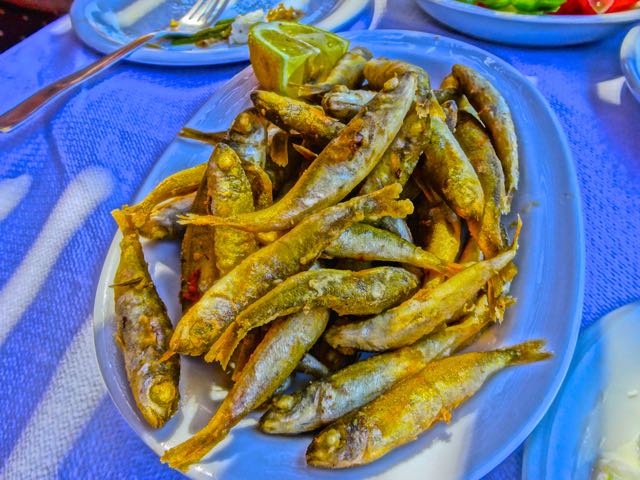 While the big fish is cooking we will have ordered some mezedes to go along with it. Among them is tarama salata (fish-row salad-photo) usually made from the eggs of carp but if you are lucky, from kefalo (gray mullet) which is what it was originally made from before the people who were eating it began to outnumber the fish who were
laying the
eggs. You have to ask if the restaurant makes it or if it comes from a container. Not that it matters. You can season the tarama from the supermarket so that it tastes pretty good. A plate of fried gavros (anchovies) is as essential as a plate of fried potatoes and are eaten the same way, with lemon or vinegar squeezed on them. Lemon makes them soggy. Vinegar keeps them crispy. Both taste great. These fish are about the size of your small finger and cooked almost whole. Their heads are cut
off because
they
give it a bitter taste. Marides (smelt) are the same size but the heads are left on. You eat the whole thing. Don't bother trying to pick out the bones or you will be there all night. Papalina are very small seasonal sardines, another great starter though normally found only in July. Even smaller are the atherinia which are to fish as onion rings are to potatoes. Maybe that's a bad analogy. (Or a ridiculous one.) So let me try to explain. In Kea, at the famous Rolando's restaurant
in Hora, he mixes atherinia with
flour and sliced
onions and then deep-fries the whole mass and serves it with vinegar and you sort of pull it apart and eat it. Like onion rings sort of. They do the same in Chios but they make it into a sort of fried cake. While the big fish is cooking we will have ordered some mezedes to go along with it. Among them is tarama salata (fish-row salad-photo) usually made from the eggs of carp but if you are lucky, from kefalo (gray mullet) which is what it was originally made from before the people who were eating it began to outnumber the fish who were
laying the
eggs. You have to ask if the restaurant makes it or if it comes from a container. Not that it matters. You can season the tarama from the supermarket so that it tastes pretty good. A plate of fried gavros (anchovies) is as essential as a plate of fried potatoes and are eaten the same way, with lemon or vinegar squeezed on them. Lemon makes them soggy. Vinegar keeps them crispy. Both taste great. These fish are about the size of your small finger and cooked almost whole. Their heads are cut
off because
they
give it a bitter taste. Marides (smelt) are the same size but the heads are left on. You eat the whole thing. Don't bother trying to pick out the bones or you will be there all night. Papalina are very small seasonal sardines, another great starter though normally found only in July. Even smaller are the atherinia which are to fish as onion rings are to potatoes. Maybe that's a bad analogy. (Or a ridiculous one.) So let me try to explain. In Kea, at the famous Rolando's restaurant
in Hora, he mixes atherinia with
flour and sliced
onions and then deep-fries the whole mass and serves it with vinegar and you sort of pull it apart and eat it. Like onion rings sort of. They do the same in Chios but they make it into a sort of fried cake.
|
|
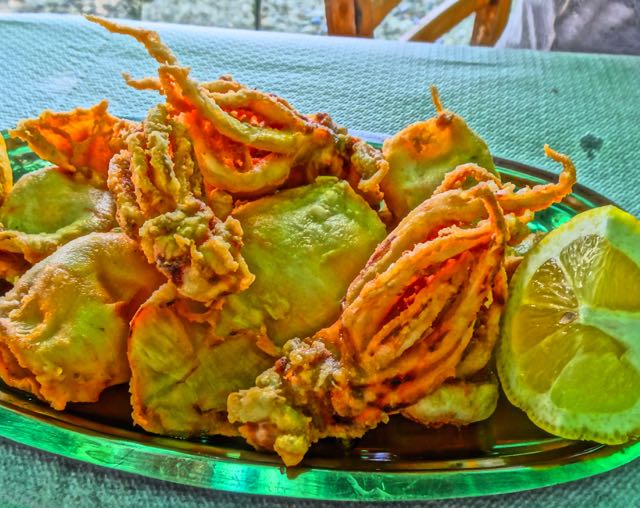 Fried kalamarakia (squid) are also listed in the mezedes-appetisers section of the menu in most restaurants since they are trying to discourage you from making a whole meal out of it since it is so cheap. Don't let that stop you. When there is fresh kalamari available the menu will tell you. In fact by law the menus
have to let
you know
whether a fish is fresh or frozen. If you see (kat) in parenthesis next to the fish you are ordering that means it is frozen. Kalamari and thrapsala are both delicious grilled or fried and can also be stuffed. But for me there is nothing like a whole fresh kalamari fried to perfection at Paradosiako Cafeneon in Athens. Unlike in America where you get kalamari and it is only the rings, which is the body cut up, in Greece they give you the legs too. There are very small kalamarakia
called gones which look like new born baby squid. In fact they may be new born baby squid for all I know. You eat them whole. Fried kalamarakia (squid) are also listed in the mezedes-appetisers section of the menu in most restaurants since they are trying to discourage you from making a whole meal out of it since it is so cheap. Don't let that stop you. When there is fresh kalamari available the menu will tell you. In fact by law the menus
have to let
you know
whether a fish is fresh or frozen. If you see (kat) in parenthesis next to the fish you are ordering that means it is frozen. Kalamari and thrapsala are both delicious grilled or fried and can also be stuffed. But for me there is nothing like a whole fresh kalamari fried to perfection at Paradosiako Cafeneon in Athens. Unlike in America where you get kalamari and it is only the rings, which is the body cut up, in Greece they give you the legs too. There are very small kalamarakia
called gones which look like new born baby squid. In fact they may be new born baby squid for all I know. You eat them whole.
|
|
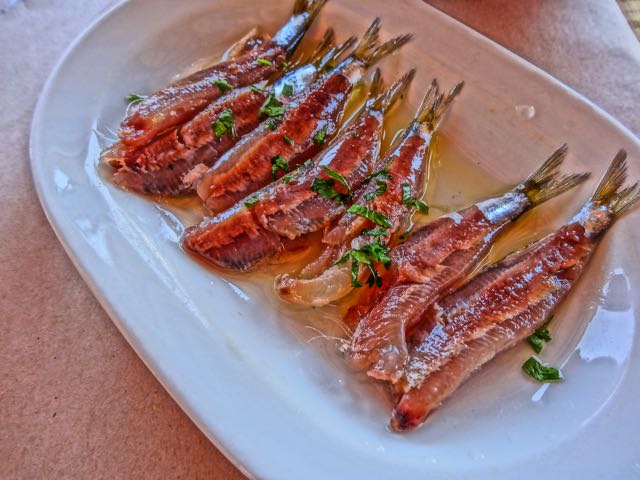 Sardeles (sardines) are eaten in several ways, either as mezedes (appetisers) or main courses. Most people like them grilled. Fried is great too. They can also be served baked in tomato sauce with lemon and oregano but this is less common. The smaller the sardines the better they are.
In Lesvos
during the month of July when the sardines are a certain size, they are eaten as sardeles pastes (photo). The fishermen go out, catch a net full of sardines in one of the two big bays, and cover them in salt. That night they are ready to eat, raw, like sushi. They go very well with ouzo, in fact they are the best thing to eat with ouzo in my opinion. You can find them later in the summer too but as the sardines grow they need to be in salt longer. I have made them myself. Eating then requires a little
technique but it can be mastered quite easily. You hold the tail of the sardine with two fingers on one half and two fingers (of the other hand) holding the other half. Then you gently pull and the fillet (but tiny) separates from the backbone. Then you take your fork and run the remaining fillet and tail through the tines (that's a real word; its the things that make a fork a fork) and separate the other filet from the backbone. Then you eat it or if you don't like it give it to the cats that have been watching
you with interest. Some restaurants serve sardeles pastes plain and others with oil, lemon or even vinegar. I like mine with oil and lemon. Sardeles (sardines) are eaten in several ways, either as mezedes (appetisers) or main courses. Most people like them grilled. Fried is great too. They can also be served baked in tomato sauce with lemon and oregano but this is less common. The smaller the sardines the better they are.
In Lesvos
during the month of July when the sardines are a certain size, they are eaten as sardeles pastes (photo). The fishermen go out, catch a net full of sardines in one of the two big bays, and cover them in salt. That night they are ready to eat, raw, like sushi. They go very well with ouzo, in fact they are the best thing to eat with ouzo in my opinion. You can find them later in the summer too but as the sardines grow they need to be in salt longer. I have made them myself. Eating then requires a little
technique but it can be mastered quite easily. You hold the tail of the sardine with two fingers on one half and two fingers (of the other hand) holding the other half. Then you gently pull and the fillet (but tiny) separates from the backbone. Then you take your fork and run the remaining fillet and tail through the tines (that's a real word; its the things that make a fork a fork) and separate the other filet from the backbone. Then you eat it or if you don't like it give it to the cats that have been watching
you with interest. Some restaurants serve sardeles pastes plain and others with oil, lemon or even vinegar. I like mine with oil and lemon.
|
|
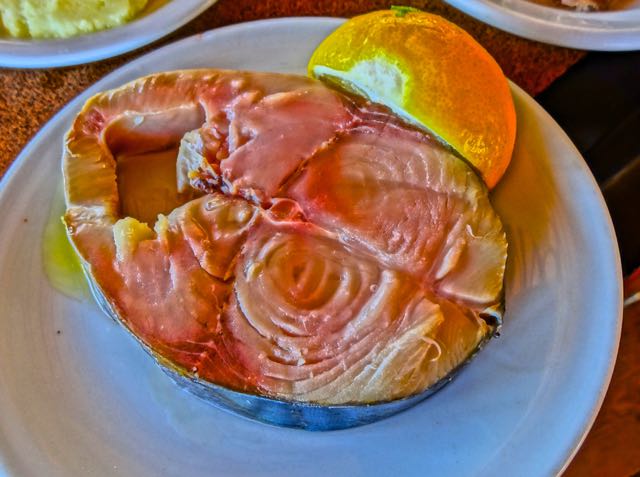 Another meze (appetiser) is lakerda, which is in the tuna or mackerel family depending on who you talk to. The fish is made into steaks about half an inch thick and marinated in lemon and olive oil for a few days before being served. This also goes well with ouzo and is a popular dish on Lesvos where perhaps the best lakerda is
found at a little hole in the wall restaurant in Campo
Antissa, known as Kostas or at just abut any restaurant in Skala Eressos or Nifida, Lesvos. They sell it in the supermarkets too but it comes from a can and is nowhere near as good. Gavros marinatos (marinated anchovies) are a less intense, less salty, fresher version than the anchovies you get on your pizza, usually served with oil and vinegar. This is also served widely in Lesvos but can also be found in many ouzeries in Athens and around the other Greek islands. The best I have tasted were
probably made by Melinda at the Captain's Table in Molyvos which were topped with oil, lemon, garlic and parsley. Lately I have been seeing gavros-marinatos sold
in gourmet food shops in the USA. Another meze (appetiser) is lakerda, which is in the tuna or mackerel family depending on who you talk to. The fish is made into steaks about half an inch thick and marinated in lemon and olive oil for a few days before being served. This also goes well with ouzo and is a popular dish on Lesvos where perhaps the best lakerda is
found at a little hole in the wall restaurant in Campo
Antissa, known as Kostas or at just abut any restaurant in Skala Eressos or Nifida, Lesvos. They sell it in the supermarkets too but it comes from a can and is nowhere near as good. Gavros marinatos (marinated anchovies) are a less intense, less salty, fresher version than the anchovies you get on your pizza, usually served with oil and vinegar. This is also served widely in Lesvos but can also be found in many ouzeries in Athens and around the other Greek islands. The best I have tasted were
probably made by Melinda at the Captain's Table in Molyvos which were topped with oil, lemon, garlic and parsley. Lately I have been seeing gavros-marinatos sold
in gourmet food shops in the USA.
|
|
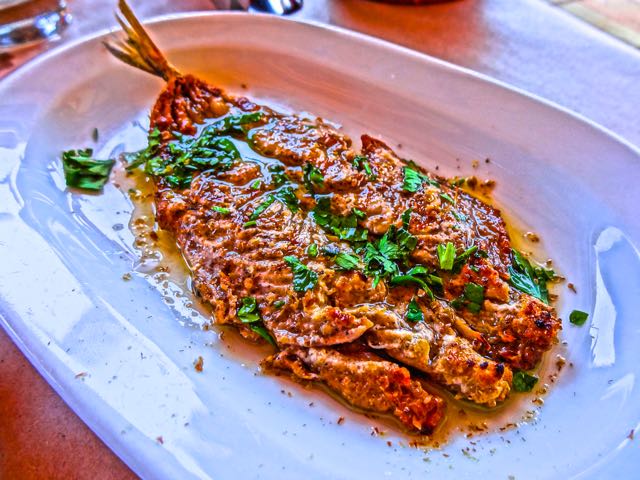 The interesting thing about Greek fish is that the cheapest ones are the best for you. Gavros, sardeles, and kolios (mackerel) are the highest in omega fatty acids and of the three kolios is the tastiest and most filling. It is usually served grilled though it can also be fried. The best kollios is made in Lesvos and is called
gouna.
The fish
is opened and dried in the sun with herbs. Then it is grilled. You won't taste anything better, especially if you go to the small town of Pirgi Thermi and eat at one of the small fish tavernas right on the water. I have also seen it in Naossa, Paros, in the port in Chios at Tsivaeri Ouzeri and in Skala Eressos, Lesvos where you can get it at Soulatso. You can usually find the restaurants that have them because they will be hanging on a clothesline along with the octopus. The interesting thing about Greek fish is that the cheapest ones are the best for you. Gavros, sardeles, and kolios (mackerel) are the highest in omega fatty acids and of the three kolios is the tastiest and most filling. It is usually served grilled though it can also be fried. The best kollios is made in Lesvos and is called
gouna.
The fish
is opened and dried in the sun with herbs. Then it is grilled. You won't taste anything better, especially if you go to the small town of Pirgi Thermi and eat at one of the small fish tavernas right on the water. I have also seen it in Naossa, Paros, in the port in Chios at Tsivaeri Ouzeri and in Skala Eressos, Lesvos where you can get it at Soulatso. You can usually find the restaurants that have them because they will be hanging on a clothesline along with the octopus.
|
|
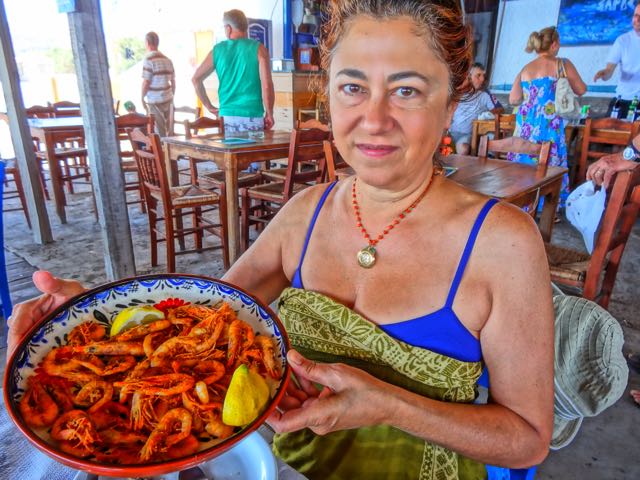 Garides (shrimp) are very common on the island of Lesvos where they are fried whole and eaten whole, even the heads. Garides saganaki is a meze of baked cheese, tomato sauce and shrimp which is found in just about every ouzerie and mezedopoulion which are restaurants that specialize in ouzo
and snacks, like
tapas.
Karaviedes are giant salt-water crayfish, very expensive and very un-satisfying. In Volos there are a number of dishes with crabs and other shellfish, that are eaten as mezedes. There is even a crab that is a very close cousin of the dungeness crab from California. In Lesvos there is something called agrio-garides which are a cross between a shrimp and a lobster tail and are deep fried and eaten whole. My daughter loves these but some people complain that they are inedible, being a little
too hard-in-shell
to eat whole and a little bit lacking-in-meat to be worth peeling. Garides (shrimp) are very common on the island of Lesvos where they are fried whole and eaten whole, even the heads. Garides saganaki is a meze of baked cheese, tomato sauce and shrimp which is found in just about every ouzerie and mezedopoulion which are restaurants that specialize in ouzo
and snacks, like
tapas.
Karaviedes are giant salt-water crayfish, very expensive and very un-satisfying. In Volos there are a number of dishes with crabs and other shellfish, that are eaten as mezedes. There is even a crab that is a very close cousin of the dungeness crab from California. In Lesvos there is something called agrio-garides which are a cross between a shrimp and a lobster tail and are deep fried and eaten whole. My daughter loves these but some people complain that they are inedible, being a little
too hard-in-shell
to eat whole and a little bit lacking-in-meat to be worth peeling.
|
|
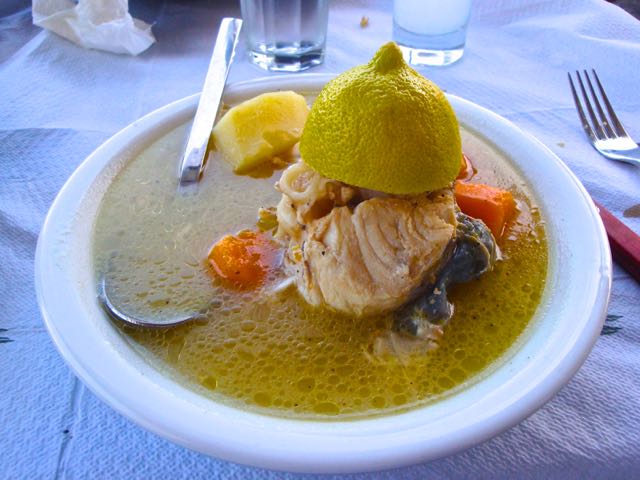 A very popular dish is psarosoupa or kakavia (fish soup), which is served at many working-class tavernas as well as the restaurants in the Plaka of Athens. The most commonly used fish is the rofos (grouper) a giant rock-dwelling fish that has to be caught one at a time and usually with a struggle. A rofos
can be half the size of
a man
and its meat can be grilled in steaks too, but more commonly it is used in psarosoupa, along with some of the other rock fish and scorpios (scorpion fish). When you order psarosoupa they ask you if you want it with the fish. If you get it with the fish it comes in a bowl with the broth and some potatoes, carrots, onions, and a plate with the fish. It is usually in an avgolemono (egg-lemon) broth. This is one of the healthiest and best tasting dishes in Greece. The fish soup at Byzantino
in Plaka is excellent.
In some island fish restaurants you can special order a whole pot by calling the day before or in the morning. We were treated to a pot at the Akrotiri Fish Taverna in Agia Focas, near Vatera Beach after the owner found out that I was the guy who had written the review that all the tourists had with them when they found this far-away restaurant. It was amazing. A very popular dish is psarosoupa or kakavia (fish soup), which is served at many working-class tavernas as well as the restaurants in the Plaka of Athens. The most commonly used fish is the rofos (grouper) a giant rock-dwelling fish that has to be caught one at a time and usually with a struggle. A rofos
can be half the size of
a man
and its meat can be grilled in steaks too, but more commonly it is used in psarosoupa, along with some of the other rock fish and scorpios (scorpion fish). When you order psarosoupa they ask you if you want it with the fish. If you get it with the fish it comes in a bowl with the broth and some potatoes, carrots, onions, and a plate with the fish. It is usually in an avgolemono (egg-lemon) broth. This is one of the healthiest and best tasting dishes in Greece. The fish soup at Byzantino
in Plaka is excellent.
In some island fish restaurants you can special order a whole pot by calling the day before or in the morning. We were treated to a pot at the Akrotiri Fish Taverna in Agia Focas, near Vatera Beach after the owner found out that I was the guy who had written the review that all the tourists had with them when they found this far-away restaurant. It was amazing.
|
|
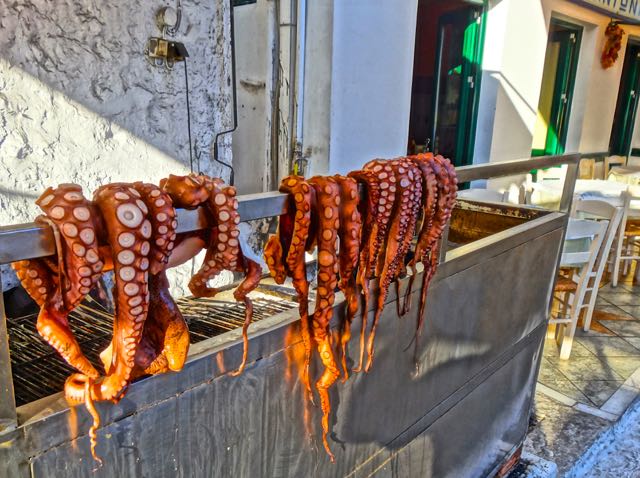 Octopus is the most misunderstood creature in the sea. Very intelligent, the Greeks have been struggling to outsmart them for centuries and now the few that remain seem to be the smartest and hardest to catch. No problem. There are plenty in China and chances are the octopus you eat in Greece will not be Greek. Still
you
have to feel a little bit sad for the slaughter of an animal that has the intelligence of a house-cat and none of the bad habits. When I was a happy yet ruthless spear-fisherman, the octopus was my most coveted prize. But after watching one in its death agony after going through the terrible procedure one must go through to make it edible (shoot it in the head, turn its head inside out and then beat it to death on a rock) I declared I would no longer hunt them and instead became their friend and savior,
often
finding them on the sea floor and whisking them to a safe hiding place before the Greek hunters, who will shoot anything no matter how small, could find them. Octopus is the most misunderstood creature in the sea. Very intelligent, the Greeks have been struggling to outsmart them for centuries and now the few that remain seem to be the smartest and hardest to catch. No problem. There are plenty in China and chances are the octopus you eat in Greece will not be Greek. Still
you
have to feel a little bit sad for the slaughter of an animal that has the intelligence of a house-cat and none of the bad habits. When I was a happy yet ruthless spear-fisherman, the octopus was my most coveted prize. But after watching one in its death agony after going through the terrible procedure one must go through to make it edible (shoot it in the head, turn its head inside out and then beat it to death on a rock) I declared I would no longer hunt them and instead became their friend and savior,
often
finding them on the sea floor and whisking them to a safe hiding place before the Greek hunters, who will shoot anything no matter how small, could find them.
|
|
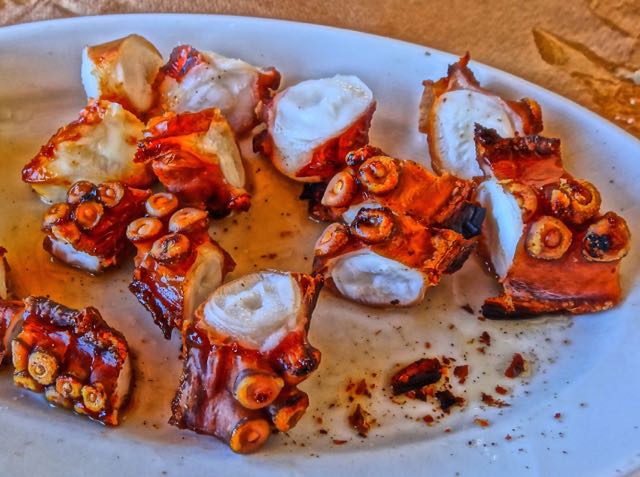 But this does not stop me from eating them and a well cooked, expertly seasoned octopus can taste like filet mignon. The best way to eat it is grilled. Marinated is good too. My last choice is with macaroni or in stifado with baby onions in tomato sauce. But you have to know how to cook an octopus because if you don't
it will take you half an hour to eat one bite. It can be very tough if not made correctly and part of the procedure is the endless beating of it on a rock. In some palaces they say the fishermen put them in a washing machine (without soap) until they are tender. A method I have used is in my cuisine-art with the bread-kneading blade until you get a white froth, almost as if you had put detergent in with it. Octopus goes best by the sea with a glass of ouzo, or even a bottle. But this does not stop me from eating them and a well cooked, expertly seasoned octopus can taste like filet mignon. The best way to eat it is grilled. Marinated is good too. My last choice is with macaroni or in stifado with baby onions in tomato sauce. But you have to know how to cook an octopus because if you don't
it will take you half an hour to eat one bite. It can be very tough if not made correctly and part of the procedure is the endless beating of it on a rock. In some palaces they say the fishermen put them in a washing machine (without soap) until they are tender. A method I have used is in my cuisine-art with the bread-kneading blade until you get a white froth, almost as if you had put detergent in with it. Octopus goes best by the sea with a glass of ouzo, or even a bottle.
|
|
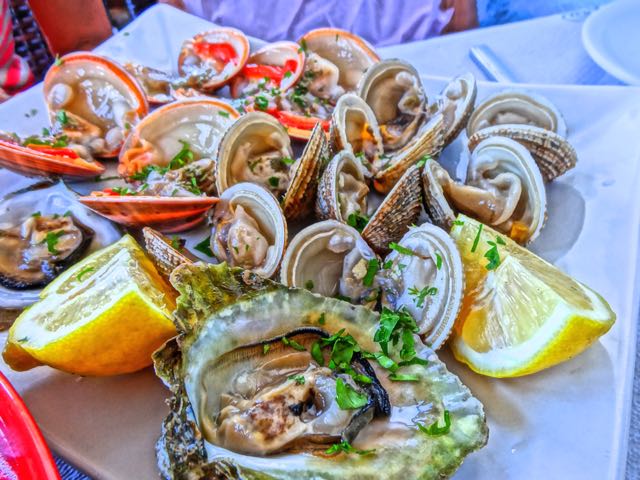 Media (mussels) have always been eaten in certain areas of Greece but now they are almost mainstream and can be found in many tavernas in Lesvos and other islands as well in Athens, either steamed or in saganaki. There are other shellfish too that have found their way on to the menus, many of them from farms but in some places
they are just picked out of the sea like these clams and oysters from Cavo d' Oro restaurant in Sigri, Lesvos. There are a number of popular fish that are now farmed
including pestrofo (fresh-water trout), salmon, eel and carp. There is talk of farming turbot, bluefin tuna, yellowtail, and octopus too. The most popular farmed fish are Tsipoura (Gilthead Sea-Bream) and Lavraki (Mediterranean Sea Bass) but I have seen Tilapia sold in the central market in Athens. If you drive along the coast you will see some of these fish farms, even as close as Sounion near Athens. Media (mussels) have always been eaten in certain areas of Greece but now they are almost mainstream and can be found in many tavernas in Lesvos and other islands as well in Athens, either steamed or in saganaki. There are other shellfish too that have found their way on to the menus, many of them from farms but in some places
they are just picked out of the sea like these clams and oysters from Cavo d' Oro restaurant in Sigri, Lesvos. There are a number of popular fish that are now farmed
including pestrofo (fresh-water trout), salmon, eel and carp. There is talk of farming turbot, bluefin tuna, yellowtail, and octopus too. The most popular farmed fish are Tsipoura (Gilthead Sea-Bream) and Lavraki (Mediterranean Sea Bass) but I have seen Tilapia sold in the central market in Athens. If you drive along the coast you will see some of these fish farms, even as close as Sounion near Athens.
|
|
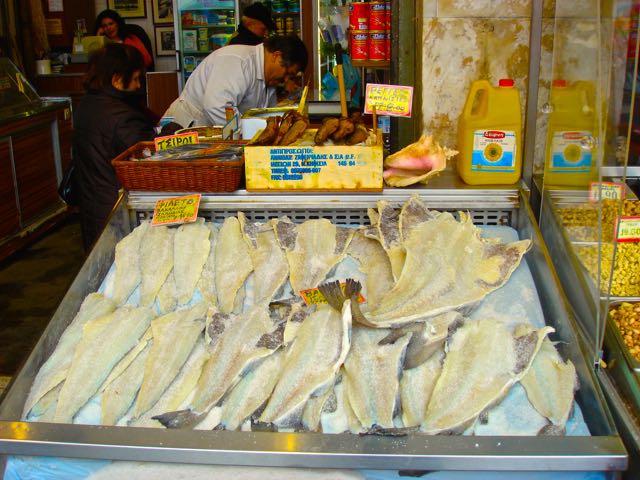 Bakaliaro (cod) is probably the most widely eaten fish, especially in the winter. If you go to the Athens Central Market or just about any island supermarket you will see salted dried cod. This can be served in a plaki, which is a sort of a roasted fish with vegetables in a tomato sauce and is usually
made with fresh cod when it is available. But the most popular way
to eat
cod is in the basement taverns of the Plaka, which are only open in the winter and specialize in bakaliaro me skordalia ( batter-dipped deep fried cod with garlic sauce). As unhealthy as it may be, for me this is the only way to eat cod. The salted cod has to be soaked for a couple days, changing the water every so often. Similar is a dish called galeos, which is actually a small shark, like what we call dog-fish, instead of 'red snapper' which is the translation many restaurants use to keep
any tourists from thinking that there may be sharks in the happy seas of Greece. Galeos
is also
deep-fried and served with skordalia. If you don't like bones then these two dishes are for you. Bakaliaro (cod) is probably the most widely eaten fish, especially in the winter. If you go to the Athens Central Market or just about any island supermarket you will see salted dried cod. This can be served in a plaki, which is a sort of a roasted fish with vegetables in a tomato sauce and is usually
made with fresh cod when it is available. But the most popular way
to eat
cod is in the basement taverns of the Plaka, which are only open in the winter and specialize in bakaliaro me skordalia ( batter-dipped deep fried cod with garlic sauce). As unhealthy as it may be, for me this is the only way to eat cod. The salted cod has to be soaked for a couple days, changing the water every so often. Similar is a dish called galeos, which is actually a small shark, like what we call dog-fish, instead of 'red snapper' which is the translation many restaurants use to keep
any tourists from thinking that there may be sharks in the happy seas of Greece. Galeos
is also
deep-fried and served with skordalia. If you don't like bones then these two dishes are for you.
|
|
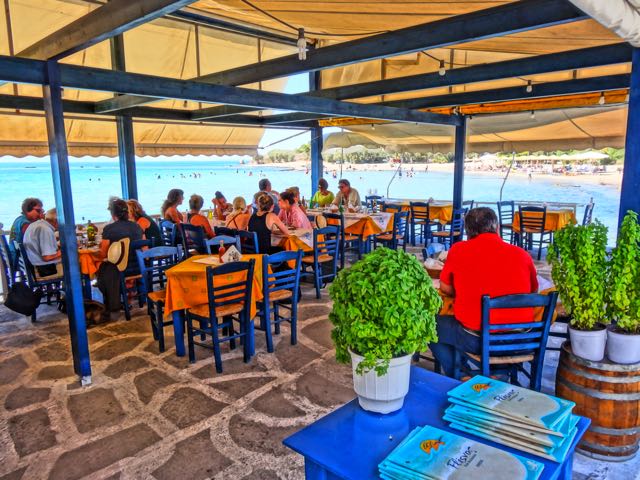 Anyone who has eaten in a sushi restaurant has encountered the delight called uni which is sea urchin. In my opinion it is the worst tasting sushi dish you can find especially when compared to fresh sea-urchin. There is only one way to eat fresh sea urchin, called archinoos, and that is to dive down and catch one, cut it open and
eat it right there. You can find it in some fish tavernas, notably on the island of Aegina at a couple of the fish tavernas between the port and the beach. But as fresh as they claim it to be, there is nothing
like eating it right out of the sea. The females are easily recognizable because they cover themselves with bits of sea weed, paper, or whatever they can find nearby. You have to pick them up carefully and bring them to the surface, take your knife and slice them open and eat the orange eggs. You won't believe how sweet they are. Don't eat too many. Anyone who has eaten in a sushi restaurant has encountered the delight called uni which is sea urchin. In my opinion it is the worst tasting sushi dish you can find especially when compared to fresh sea-urchin. There is only one way to eat fresh sea urchin, called archinoos, and that is to dive down and catch one, cut it open and
eat it right there. You can find it in some fish tavernas, notably on the island of Aegina at a couple of the fish tavernas between the port and the beach. But as fresh as they claim it to be, there is nothing
like eating it right out of the sea. The females are easily recognizable because they cover themselves with bits of sea weed, paper, or whatever they can find nearby. You have to pick them up carefully and bring them to the surface, take your knife and slice them open and eat the orange eggs. You won't believe how sweet they are. Don't eat too many.
|
|
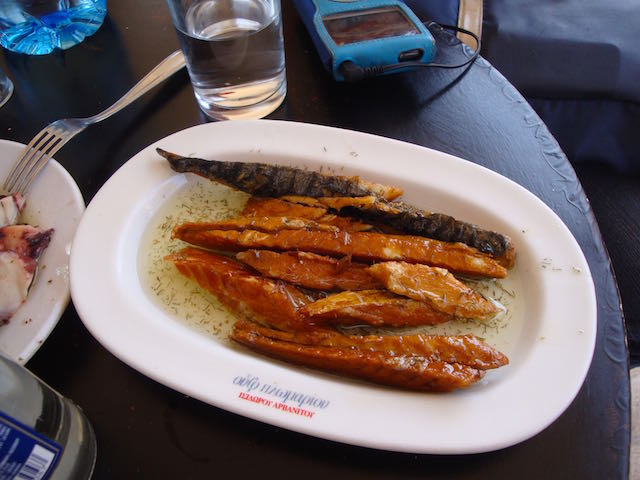 In the Athens Central market and in smaller markets on the islands you can find rega, (smoked herring) which is served covered in olive oil and considered a winter food because it is so salty. You can make a really nice rega-salata, a spread like taramasalata, by soaking bread and then grinding it up in a cuisinart with
onions, garlic and de-boned smoked herring (or mackerel) and olive oil. You can find all sorts of canned sardines, some in olive oil which you can just open and eat, and some that is caked in salt which takes some work to
make
edible. You can also find in cans or packaged in plastic containers kolios (mackerel), gavros (anchovies), lakerda (bonito-tuna) and even marinated octopus. Skoumbri which is in the mackerel family is sold whole and pickled and if you are a pickled fish fanatic you will love it, but if not you may want to let it go. It will stink up your hotel room and may even alert the airport dogs to contraband. But the smoked skoumbri which comes in tins but is also sold in many
fish tavernas in Lesvos will be one of the best canned fishes you have ever tasted. In the Athens Central market and in smaller markets on the islands you can find rega, (smoked herring) which is served covered in olive oil and considered a winter food because it is so salty. You can make a really nice rega-salata, a spread like taramasalata, by soaking bread and then grinding it up in a cuisinart with
onions, garlic and de-boned smoked herring (or mackerel) and olive oil. You can find all sorts of canned sardines, some in olive oil which you can just open and eat, and some that is caked in salt which takes some work to
make
edible. You can also find in cans or packaged in plastic containers kolios (mackerel), gavros (anchovies), lakerda (bonito-tuna) and even marinated octopus. Skoumbri which is in the mackerel family is sold whole and pickled and if you are a pickled fish fanatic you will love it, but if not you may want to let it go. It will stink up your hotel room and may even alert the airport dogs to contraband. But the smoked skoumbri which comes in tins but is also sold in many
fish tavernas in Lesvos will be one of the best canned fishes you have ever tasted.
|
|
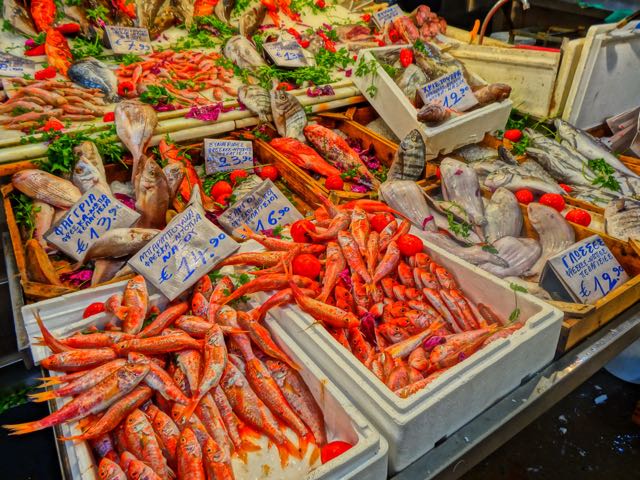 Also in the probably not-a-good-idea-to-eat category are the kefalo (gray mullet) which live in the harbors and eat the bread that the tourists toss to them. These fish tend to like polluted water though that does not mean that because you see them in the sea that the water is polluted because they are everywhere.
They are sold in some
restaurants and in the central market. When they are fresh and clean their gills will be exposed and a bright red. Another interesting fish that you may come across is the smyrna (moray eel) which are fairly common in the Greek sea though you probably won't see them unless you are diving after sunset. They are big and nasty looking with the sharpest little teeth you have ever seen. They are quite edible, delicious fried, but such a pain to clean that few chefs will mess with them. You
don't have to be afraid of them unless you are snorkeling and decide to tease one by sticking your hand in his hole. Also in the probably not-a-good-idea-to-eat category are the kefalo (gray mullet) which live in the harbors and eat the bread that the tourists toss to them. These fish tend to like polluted water though that does not mean that because you see them in the sea that the water is polluted because they are everywhere.
They are sold in some
restaurants and in the central market. When they are fresh and clean their gills will be exposed and a bright red. Another interesting fish that you may come across is the smyrna (moray eel) which are fairly common in the Greek sea though you probably won't see them unless you are diving after sunset. They are big and nasty looking with the sharpest little teeth you have ever seen. They are quite edible, delicious fried, but such a pain to clean that few chefs will mess with them. You
don't have to be afraid of them unless you are snorkeling and decide to tease one by sticking your hand in his hole.
|
|
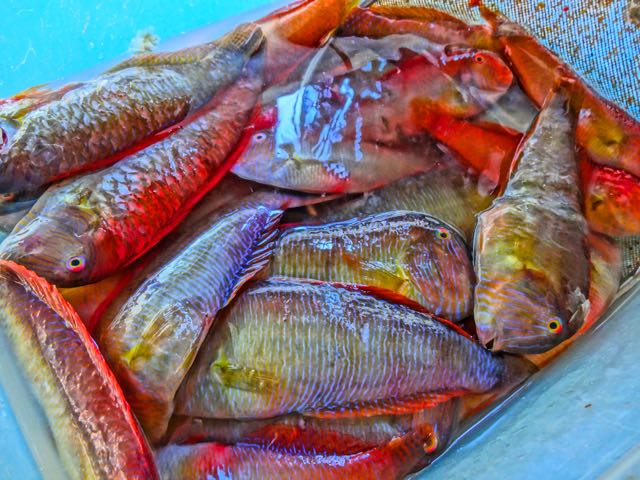 One of my favorite fish which is also not usually found in restaurants unless some fisherman just happened to catch some by accident is the skaros, described by the ancient Greeks as the parrot fish, which is grilled whole, guts, scales and all. In fact there is a little song the fishermen sing about the skaros: One of my favorite fish which is also not usually found in restaurants unless some fisherman just happened to catch some by accident is the skaros, described by the ancient Greeks as the parrot fish, which is grilled whole, guts, scales and all. In fact there is a little song the fishermen sing about the skaros:
The rofos you eat the head
melanouri the body
but for skaros eat the shit
and tell me which do you like better?
Well I don't know if the fisherman actually sit around singing the skaros song but it was taught to me by a fisherman. I used to see these in schools of hundreds in my grandmother's village in the Peloponessos but they are only in certain places. But when I see them in a restaurant and they are fresh I do order them. Make sure they don't clean them if you order them too.
|
|
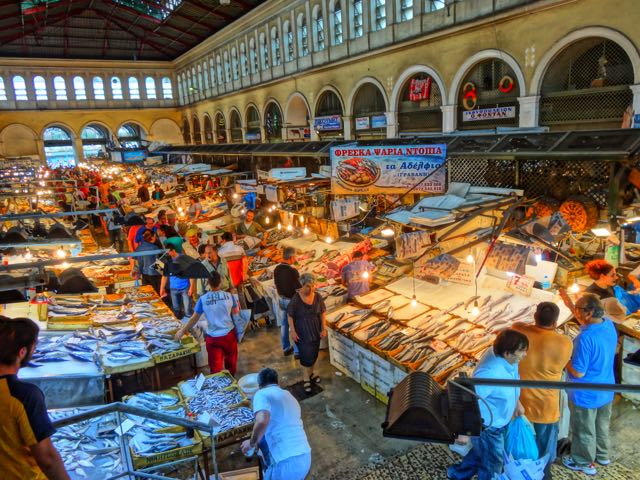 For a real treat visit the fish section of the Athens Central market on any weekday or Saturday morning. You will see just about every fish in Greece and many from outside Greece and even outside the Mediterranean. Make sure you are not wearing flip-flops or open sandals because the floor can be wet and nasty. If you are staying in a hotel
there is really not much that you can buy here but it is a neat experience, right up there with the museums and archaeological
sites of Athens. To find the market you walk towards Omonia Square from Monastiraki Square and it is about halfway there, on your right. Be sure you bring your camera and watch your wallet too. You can see photos and read more about it on my Athens Market page. For a real treat visit the fish section of the Athens Central market on any weekday or Saturday morning. You will see just about every fish in Greece and many from outside Greece and even outside the Mediterranean. Make sure you are not wearing flip-flops or open sandals because the floor can be wet and nasty. If you are staying in a hotel
there is really not much that you can buy here but it is a neat experience, right up there with the museums and archaeological
sites of Athens. To find the market you walk towards Omonia Square from Monastiraki Square and it is about halfway there, on your right. Be sure you bring your camera and watch your wallet too. You can see photos and read more about it on my Athens Market page.
|
|
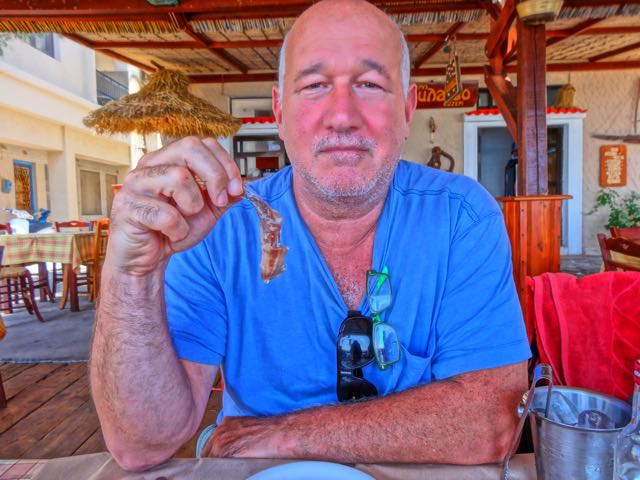 Remember too that when you go to a fish restaurant some of the fish will be sold by the merida (portion) and some by the kilo. Look at the price per kilo before you order so you don't get surprised when you get the bill. The waiter will always recommend the most expensive fish. What are my favorite fish? In this order they
are: fried
barbounia, sardeles pastes, grilled kollios, grilled octopus, fried gavros, grilled sardines and bakaliaro me skordalia. The best places for fish? Just about anywhere on the island of Lesvos and a dozen or so other islands. In Athens the fish-tavernas at Anavissos are worth the trip especially if you want to visit Sounion. If you are in the city the small Paradosiako Cafeneon on Voulis street makes great fried and grilled fish, usually of the inexpensive variety,
and if you are in Psiri try to find Atlantiko for inexpensive fish. It is in an alley right around the corner from Cafe Ivi if that helps. If you are anywhere near Victoria Square try Ouzeri Lakis on Elpidos Street which is a small pedestrian street that is halfway down the square. Violetta in Foikinos Negri is a nice
little fish-taverna too and right across the street is Blasis Psaradiko-Psarafago a combination fish market/fish restaurant with a great concept. You buy the fish by the kilo and you pay them to cook it. On the road to Kessariani there are a number of fish tavernas in Anagenisios Square. But for more about where to eat fish you should probably read Eating Seafood in Athens. Remember too that when you go to a fish restaurant some of the fish will be sold by the merida (portion) and some by the kilo. Look at the price per kilo before you order so you don't get surprised when you get the bill. The waiter will always recommend the most expensive fish. What are my favorite fish? In this order they
are: fried
barbounia, sardeles pastes, grilled kollios, grilled octopus, fried gavros, grilled sardines and bakaliaro me skordalia. The best places for fish? Just about anywhere on the island of Lesvos and a dozen or so other islands. In Athens the fish-tavernas at Anavissos are worth the trip especially if you want to visit Sounion. If you are in the city the small Paradosiako Cafeneon on Voulis street makes great fried and grilled fish, usually of the inexpensive variety,
and if you are in Psiri try to find Atlantiko for inexpensive fish. It is in an alley right around the corner from Cafe Ivi if that helps. If you are anywhere near Victoria Square try Ouzeri Lakis on Elpidos Street which is a small pedestrian street that is halfway down the square. Violetta in Foikinos Negri is a nice
little fish-taverna too and right across the street is Blasis Psaradiko-Psarafago a combination fish market/fish restaurant with a great concept. You buy the fish by the kilo and you pay them to cook it. On the road to Kessariani there are a number of fish tavernas in Anagenisios Square. But for more about where to eat fish you should probably read Eating Seafood in Athens.
|
|

 If you take a look at a map of Greece you will see why fish is such an important part of the Greek diet. For such a small country there is a lot of coastline which is why they have a strong history of seafaring. Eating seafood goes along with that. Unfortunately the sea which was once so abundant
is now barren in places because of over-fishing and the Aegean sea simply can't keep up with the demand of a seafood-loving population whose numbers swell during the tourist
season. Fish can be very expensive, though there are inexpensive fish available year-round, and these are just as tasty as the expensive ones. Let us start at the bottom and make our way up the fish chain going from the cheapest to the most expensive and hopefully after reading this article you will be able to have a nice fish dinner in Greece without spending more than you spent on your flight to Greece. Incidently speaking of flights to Greece, the first thing I do when I get off the plane is have
If you take a look at a map of Greece you will see why fish is such an important part of the Greek diet. For such a small country there is a lot of coastline which is why they have a strong history of seafaring. Eating seafood goes along with that. Unfortunately the sea which was once so abundant
is now barren in places because of over-fishing and the Aegean sea simply can't keep up with the demand of a seafood-loving population whose numbers swell during the tourist
season. Fish can be very expensive, though there are inexpensive fish available year-round, and these are just as tasty as the expensive ones. Let us start at the bottom and make our way up the fish chain going from the cheapest to the most expensive and hopefully after reading this article you will be able to have a nice fish dinner in Greece without spending more than you spent on your flight to Greece. Incidently speaking of flights to Greece, the first thing I do when I get off the plane is have  The cheapest fish are sardeles (sardines), gavros (anchovies), kolios (mackerel), gopa (bogue) and marides (smelt). Also in this inexpensive category are kalamari (squid), though only the frozen variety which is usually, if not always, imported from California,
China and other far away places. When kalamari is in season they will tell you on the menu that it is fresh. When cut and fried it is usually frozen but fresh kalamari is grilled or fried whole. In the kalamari family is also thrapsala which to you and I looks like a squid and tastes like a squid but is not a squid. Well maybe it is a squid but they call it thrapsala and like fresh kalamari they serve it grilled or fried whole. In the same family are soupia (cuttlefish) which
have
shorter
tentacles and are never fried but cooked in a stew with tomato sauce. Octopus, which is eaten in small amounts as a meze (snack) can be local or can come from China or the Atlantic. Octopus can be served in a number of ways which I will go into later. In between there are a number of fish whose price depends on supply and include xifia (sword fish), a couple varieties of Mediterranean tuna, and a whole family of bream, trout and even mollusks. Included among them is fagri (red porgy), sargos
(sea-bream), lavraki (sea bass), lithrini (pandora), and synagrida (dentex) most of which are either baked or grilled and sold by the kilo. More and more fish are now farmed so if you have a problem with that be sure to ask at the restaurant. The most likely fish to be from a farm are sargos
(sea-bream) and lavraki (sea bass), which Greece is the number 1 country in the EU and number 3 in the world for production.
The cheapest fish are sardeles (sardines), gavros (anchovies), kolios (mackerel), gopa (bogue) and marides (smelt). Also in this inexpensive category are kalamari (squid), though only the frozen variety which is usually, if not always, imported from California,
China and other far away places. When kalamari is in season they will tell you on the menu that it is fresh. When cut and fried it is usually frozen but fresh kalamari is grilled or fried whole. In the kalamari family is also thrapsala which to you and I looks like a squid and tastes like a squid but is not a squid. Well maybe it is a squid but they call it thrapsala and like fresh kalamari they serve it grilled or fried whole. In the same family are soupia (cuttlefish) which
have
shorter
tentacles and are never fried but cooked in a stew with tomato sauce. Octopus, which is eaten in small amounts as a meze (snack) can be local or can come from China or the Atlantic. Octopus can be served in a number of ways which I will go into later. In between there are a number of fish whose price depends on supply and include xifia (sword fish), a couple varieties of Mediterranean tuna, and a whole family of bream, trout and even mollusks. Included among them is fagri (red porgy), sargos
(sea-bream), lavraki (sea bass), lithrini (pandora), and synagrida (dentex) most of which are either baked or grilled and sold by the kilo. More and more fish are now farmed so if you have a problem with that be sure to ask at the restaurant. The most likely fish to be from a farm are sargos
(sea-bream) and lavraki (sea bass), which Greece is the number 1 country in the EU and number 3 in the world for production. Then at the top of the fish food chain is astakos (lobster), which can cost a small fortune and is familiar to anyone who has taken a charter sailboat around the islands because many skippers take their clients to the tavernas that serve fresh lobster or the newly popular astako makaronada (macaroni with lobster). Not surprising
since skippers
often get a commission from the restaurants for any business they bring and a table full of lobster can cost a few hundred euros or more. But here's a tip. Save your lobster-money for home. Mediterranean lobsters are over-rated, under-tasty and few chefs have mastered the cooking of these creatures. They also lack claws which besides the tails are the only edible part unless you want to spend the night sucking bits of meat from legs and antennae. (Yes. The Greek lobsters have meat in the antennae! But not enough
to justify eating them.) In Milos I did see lobsters with claws at the restaurant of the famous Roberto at Da Peppe. "Where did you find lobsters with claws?" I asked him in wonder. "On the airplane" he said in his broken English. They were flown in, maybe from Maine, definitely from somewhere on the Atlantic.
Then at the top of the fish food chain is astakos (lobster), which can cost a small fortune and is familiar to anyone who has taken a charter sailboat around the islands because many skippers take their clients to the tavernas that serve fresh lobster or the newly popular astako makaronada (macaroni with lobster). Not surprising
since skippers
often get a commission from the restaurants for any business they bring and a table full of lobster can cost a few hundred euros or more. But here's a tip. Save your lobster-money for home. Mediterranean lobsters are over-rated, under-tasty and few chefs have mastered the cooking of these creatures. They also lack claws which besides the tails are the only edible part unless you want to spend the night sucking bits of meat from legs and antennae. (Yes. The Greek lobsters have meat in the antennae! But not enough
to justify eating them.) In Milos I did see lobsters with claws at the restaurant of the famous Roberto at Da Peppe. "Where did you find lobsters with claws?" I asked him in wonder. "On the airplane" he said in his broken English. They were flown in, maybe from Maine, definitely from somewhere on the Atlantic. So while you are allowing the lobsters of Greece to re-establish themselves and maybe grow some claws, what can someone who wants to spend a lot of money on fish buy that is worth the expense. I have one word. Barbounia. The red-mullet is the best tasting fish you will ever eat, whether fried or grilled.
Is it worth 55 euros a kilo? Well, luckily
you can't eat a kilo. Half a kilo is enough for two and though you may want more after the last morsel of fish, skin or even bone is eaten, chances are there will be other fish on the table too. For those who think 55 euros is a little steep there are koutsomoures, the paler cousins of the barbouni, which some people like better and are cheaper. By the way just for the record I prefer barbounia and koutsomoura fried and if you order it this way there should not be much of a fish left
when you are finished. Usually the only thing left on my plate is the backbone.
So while you are allowing the lobsters of Greece to re-establish themselves and maybe grow some claws, what can someone who wants to spend a lot of money on fish buy that is worth the expense. I have one word. Barbounia. The red-mullet is the best tasting fish you will ever eat, whether fried or grilled.
Is it worth 55 euros a kilo? Well, luckily
you can't eat a kilo. Half a kilo is enough for two and though you may want more after the last morsel of fish, skin or even bone is eaten, chances are there will be other fish on the table too. For those who think 55 euros is a little steep there are koutsomoures, the paler cousins of the barbouni, which some people like better and are cheaper. By the way just for the record I prefer barbounia and koutsomoura fried and if you order it this way there should not be much of a fish left
when you are finished. Usually the only thing left on my plate is the backbone.  Going out for a fish dinner is always a fun time if you are with someone who knows what they are doing. Usually the fish restaurants are on the sea, outside of Athens. One of my favorite areas is Anavissos, on the way to Sounion, a small seaside town famous for its fish tavernas. There are waiters standing in the
road beckoning for
you to park
your car by their dining area so they can impress you with their fresh fish, keeping in mind that if the sea has been rough for several days there may not be any fresh fish. But once you sit down and look over the menu the procedure is for the leader of your group (the guy who knows what he is doing) to follow the waiter to the kitchen where he is shown what fish is available. If you are with George, my friend from Fantasy Travel, you will bring my daughter Amarandi in and allow her to pick the fish, which she
will. The biggest one she sees, usually a fagria, sargos, or tsipoura, all in the bream family and delicious grilled and costing more than I normally like to spend on several dinners.
Going out for a fish dinner is always a fun time if you are with someone who knows what they are doing. Usually the fish restaurants are on the sea, outside of Athens. One of my favorite areas is Anavissos, on the way to Sounion, a small seaside town famous for its fish tavernas. There are waiters standing in the
road beckoning for
you to park
your car by their dining area so they can impress you with their fresh fish, keeping in mind that if the sea has been rough for several days there may not be any fresh fish. But once you sit down and look over the menu the procedure is for the leader of your group (the guy who knows what he is doing) to follow the waiter to the kitchen where he is shown what fish is available. If you are with George, my friend from Fantasy Travel, you will bring my daughter Amarandi in and allow her to pick the fish, which she
will. The biggest one she sees, usually a fagria, sargos, or tsipoura, all in the bream family and delicious grilled and costing more than I normally like to spend on several dinners.  While the big fish is cooking we will have ordered some mezedes to go along with it. Among them is tarama salata (fish-row salad-photo) usually made from the eggs of carp but if you are lucky, from kefalo (gray mullet) which is what it was originally made from before the people who were eating it began to outnumber the fish who were
laying the
eggs. You have to ask if the restaurant makes it or if it comes from a container. Not that it matters. You can season the tarama from the supermarket so that it tastes pretty good. A plate of fried gavros (anchovies) is as essential as a plate of fried potatoes and are eaten the same way, with lemon or vinegar squeezed on them. Lemon makes them soggy. Vinegar keeps them crispy. Both taste great. These fish are about the size of your small finger and cooked almost whole. Their heads are cut
off because
they
give it a bitter taste. Marides (smelt) are the same size but the heads are left on. You eat the whole thing. Don't bother trying to pick out the bones or you will be there all night. Papalina are very small seasonal sardines, another great starter though normally found only in July. Even smaller are the atherinia which are to fish as onion rings are to potatoes. Maybe that's a bad analogy. (Or a ridiculous one.) So let me try to explain. In Kea, at the famous Rolando's restaurant
in Hora, he mixes atherinia with
flour and sliced
onions and then deep-fries the whole mass and serves it with vinegar and you sort of pull it apart and eat it. Like onion rings sort of. They do the same in Chios but they make it into a sort of fried cake.
While the big fish is cooking we will have ordered some mezedes to go along with it. Among them is tarama salata (fish-row salad-photo) usually made from the eggs of carp but if you are lucky, from kefalo (gray mullet) which is what it was originally made from before the people who were eating it began to outnumber the fish who were
laying the
eggs. You have to ask if the restaurant makes it or if it comes from a container. Not that it matters. You can season the tarama from the supermarket so that it tastes pretty good. A plate of fried gavros (anchovies) is as essential as a plate of fried potatoes and are eaten the same way, with lemon or vinegar squeezed on them. Lemon makes them soggy. Vinegar keeps them crispy. Both taste great. These fish are about the size of your small finger and cooked almost whole. Their heads are cut
off because
they
give it a bitter taste. Marides (smelt) are the same size but the heads are left on. You eat the whole thing. Don't bother trying to pick out the bones or you will be there all night. Papalina are very small seasonal sardines, another great starter though normally found only in July. Even smaller are the atherinia which are to fish as onion rings are to potatoes. Maybe that's a bad analogy. (Or a ridiculous one.) So let me try to explain. In Kea, at the famous Rolando's restaurant
in Hora, he mixes atherinia with
flour and sliced
onions and then deep-fries the whole mass and serves it with vinegar and you sort of pull it apart and eat it. Like onion rings sort of. They do the same in Chios but they make it into a sort of fried cake. Fried kalamarakia (squid) are also listed in the mezedes-appetisers section of the menu in most restaurants since they are trying to discourage you from making a whole meal out of it since it is so cheap. Don't let that stop you. When there is fresh kalamari available the menu will tell you. In fact by law the menus
have to let
you know
whether a fish is fresh or frozen. If you see (kat) in parenthesis next to the fish you are ordering that means it is frozen. Kalamari and thrapsala are both delicious grilled or fried and can also be stuffed. But for me there is nothing like a whole fresh kalamari fried to perfection at Paradosiako Cafeneon in Athens. Unlike in America where you get kalamari and it is only the rings, which is the body cut up, in Greece they give you the legs too. There are very small kalamarakia
called gones which look like new born baby squid. In fact they may be new born baby squid for all I know. You eat them whole.
Fried kalamarakia (squid) are also listed in the mezedes-appetisers section of the menu in most restaurants since they are trying to discourage you from making a whole meal out of it since it is so cheap. Don't let that stop you. When there is fresh kalamari available the menu will tell you. In fact by law the menus
have to let
you know
whether a fish is fresh or frozen. If you see (kat) in parenthesis next to the fish you are ordering that means it is frozen. Kalamari and thrapsala are both delicious grilled or fried and can also be stuffed. But for me there is nothing like a whole fresh kalamari fried to perfection at Paradosiako Cafeneon in Athens. Unlike in America where you get kalamari and it is only the rings, which is the body cut up, in Greece they give you the legs too. There are very small kalamarakia
called gones which look like new born baby squid. In fact they may be new born baby squid for all I know. You eat them whole. Sardeles (sardines) are eaten in several ways, either as mezedes (appetisers) or main courses. Most people like them grilled. Fried is great too. They can also be served baked in tomato sauce with lemon and oregano but this is less common. The smaller the sardines the better they are.
In Lesvos
during the month of July when the sardines are a certain size, they are eaten as sardeles pastes (photo). The fishermen go out, catch a net full of sardines in one of the two big bays, and cover them in salt. That night they are ready to eat, raw, like sushi. They go very well with ouzo, in fact they are the best thing to eat with ouzo in my opinion. You can find them later in the summer too but as the sardines grow they need to be in salt longer. I have made them myself. Eating then requires a little
technique but it can be mastered quite easily. You hold the tail of the sardine with two fingers on one half and two fingers (of the other hand) holding the other half. Then you gently pull and the fillet (but tiny) separates from the backbone. Then you take your fork and run the remaining fillet and tail through the tines (that's a real word; its the things that make a fork a fork) and separate the other filet from the backbone. Then you eat it or if you don't like it give it to the cats that have been watching
you with interest. Some restaurants serve sardeles pastes plain and others with oil, lemon or even vinegar. I like mine with oil and lemon.
Sardeles (sardines) are eaten in several ways, either as mezedes (appetisers) or main courses. Most people like them grilled. Fried is great too. They can also be served baked in tomato sauce with lemon and oregano but this is less common. The smaller the sardines the better they are.
In Lesvos
during the month of July when the sardines are a certain size, they are eaten as sardeles pastes (photo). The fishermen go out, catch a net full of sardines in one of the two big bays, and cover them in salt. That night they are ready to eat, raw, like sushi. They go very well with ouzo, in fact they are the best thing to eat with ouzo in my opinion. You can find them later in the summer too but as the sardines grow they need to be in salt longer. I have made them myself. Eating then requires a little
technique but it can be mastered quite easily. You hold the tail of the sardine with two fingers on one half and two fingers (of the other hand) holding the other half. Then you gently pull and the fillet (but tiny) separates from the backbone. Then you take your fork and run the remaining fillet and tail through the tines (that's a real word; its the things that make a fork a fork) and separate the other filet from the backbone. Then you eat it or if you don't like it give it to the cats that have been watching
you with interest. Some restaurants serve sardeles pastes plain and others with oil, lemon or even vinegar. I like mine with oil and lemon. Another meze (appetiser) is lakerda, which is in the tuna or mackerel family depending on who you talk to. The fish is made into steaks about half an inch thick and marinated in lemon and olive oil for a few days before being served. This also goes well with ouzo and is a popular dish on Lesvos where perhaps the best lakerda is
found at a little hole in the wall restaurant in Campo
Antissa, known as Kostas or at just abut any restaurant in Skala Eressos or Nifida, Lesvos. They sell it in the supermarkets too but it comes from a can and is nowhere near as good. Gavros marinatos (marinated anchovies) are a less intense, less salty, fresher version than the anchovies you get on your pizza, usually served with oil and vinegar. This is also served widely in Lesvos but can also be found in many ouzeries in Athens and around the other Greek islands. The best I have tasted were
probably made by Melinda at the Captain's Table in Molyvos which were topped with oil, lemon, garlic and parsley. Lately I have been seeing gavros-marinatos sold
in gourmet food shops in the USA.
Another meze (appetiser) is lakerda, which is in the tuna or mackerel family depending on who you talk to. The fish is made into steaks about half an inch thick and marinated in lemon and olive oil for a few days before being served. This also goes well with ouzo and is a popular dish on Lesvos where perhaps the best lakerda is
found at a little hole in the wall restaurant in Campo
Antissa, known as Kostas or at just abut any restaurant in Skala Eressos or Nifida, Lesvos. They sell it in the supermarkets too but it comes from a can and is nowhere near as good. Gavros marinatos (marinated anchovies) are a less intense, less salty, fresher version than the anchovies you get on your pizza, usually served with oil and vinegar. This is also served widely in Lesvos but can also be found in many ouzeries in Athens and around the other Greek islands. The best I have tasted were
probably made by Melinda at the Captain's Table in Molyvos which were topped with oil, lemon, garlic and parsley. Lately I have been seeing gavros-marinatos sold
in gourmet food shops in the USA. The interesting thing about Greek fish is that the cheapest ones are the best for you. Gavros, sardeles, and kolios (mackerel) are the highest in omega fatty acids and of the three kolios is the tastiest and most filling. It is usually served grilled though it can also be fried. The best kollios is made in Lesvos and is called
gouna.
The fish
is opened and dried in the sun with herbs. Then it is grilled. You won't taste anything better, especially if you go to the small town of Pirgi Thermi and eat at one of the small fish tavernas right on the water. I have also seen it in Naossa, Paros, in the port in Chios at Tsivaeri Ouzeri and in Skala Eressos, Lesvos where you can get it at Soulatso. You can usually find the restaurants that have them because they will be hanging on a clothesline along with the octopus.
The interesting thing about Greek fish is that the cheapest ones are the best for you. Gavros, sardeles, and kolios (mackerel) are the highest in omega fatty acids and of the three kolios is the tastiest and most filling. It is usually served grilled though it can also be fried. The best kollios is made in Lesvos and is called
gouna.
The fish
is opened and dried in the sun with herbs. Then it is grilled. You won't taste anything better, especially if you go to the small town of Pirgi Thermi and eat at one of the small fish tavernas right on the water. I have also seen it in Naossa, Paros, in the port in Chios at Tsivaeri Ouzeri and in Skala Eressos, Lesvos where you can get it at Soulatso. You can usually find the restaurants that have them because they will be hanging on a clothesline along with the octopus.  Garides (shrimp) are very common on the island of Lesvos where they are fried whole and eaten whole, even the heads. Garides saganaki is a meze of baked cheese, tomato sauce and shrimp which is found in just about every ouzerie and mezedopoulion which are restaurants that specialize in ouzo
and snacks, like
tapas.
Karaviedes are giant salt-water crayfish, very expensive and very un-satisfying. In Volos there are a number of dishes with crabs and other shellfish, that are eaten as mezedes. There is even a crab that is a very close cousin of the dungeness crab from California. In Lesvos there is something called agrio-garides which are a cross between a shrimp and a lobster tail and are deep fried and eaten whole. My daughter loves these but some people complain that they are inedible, being a little
too hard-in-shell
to eat whole and a little bit lacking-in-meat to be worth peeling.
Garides (shrimp) are very common on the island of Lesvos where they are fried whole and eaten whole, even the heads. Garides saganaki is a meze of baked cheese, tomato sauce and shrimp which is found in just about every ouzerie and mezedopoulion which are restaurants that specialize in ouzo
and snacks, like
tapas.
Karaviedes are giant salt-water crayfish, very expensive and very un-satisfying. In Volos there are a number of dishes with crabs and other shellfish, that are eaten as mezedes. There is even a crab that is a very close cousin of the dungeness crab from California. In Lesvos there is something called agrio-garides which are a cross between a shrimp and a lobster tail and are deep fried and eaten whole. My daughter loves these but some people complain that they are inedible, being a little
too hard-in-shell
to eat whole and a little bit lacking-in-meat to be worth peeling. A very popular dish is psarosoupa or kakavia (fish soup), which is served at many working-class tavernas as well as the restaurants in the Plaka of Athens. The most commonly used fish is the rofos (grouper) a giant rock-dwelling fish that has to be caught one at a time and usually with a struggle. A rofos
can be half the size of
a man
and its meat can be grilled in steaks too, but more commonly it is used in psarosoupa, along with some of the other rock fish and scorpios (scorpion fish). When you order psarosoupa they ask you if you want it with the fish. If you get it with the fish it comes in a bowl with the broth and some potatoes, carrots, onions, and a plate with the fish. It is usually in an avgolemono (egg-lemon) broth. This is one of the healthiest and best tasting dishes in Greece. The fish soup at Byzantino
in Plaka is excellent.
In some island fish restaurants you can special order a whole pot by calling the day before or in the morning. We were treated to a pot at the Akrotiri Fish Taverna in Agia Focas, near Vatera Beach after the owner found out that I was the guy who had written the review that all the tourists had with them when they found this far-away restaurant. It was amazing.
A very popular dish is psarosoupa or kakavia (fish soup), which is served at many working-class tavernas as well as the restaurants in the Plaka of Athens. The most commonly used fish is the rofos (grouper) a giant rock-dwelling fish that has to be caught one at a time and usually with a struggle. A rofos
can be half the size of
a man
and its meat can be grilled in steaks too, but more commonly it is used in psarosoupa, along with some of the other rock fish and scorpios (scorpion fish). When you order psarosoupa they ask you if you want it with the fish. If you get it with the fish it comes in a bowl with the broth and some potatoes, carrots, onions, and a plate with the fish. It is usually in an avgolemono (egg-lemon) broth. This is one of the healthiest and best tasting dishes in Greece. The fish soup at Byzantino
in Plaka is excellent.
In some island fish restaurants you can special order a whole pot by calling the day before or in the morning. We were treated to a pot at the Akrotiri Fish Taverna in Agia Focas, near Vatera Beach after the owner found out that I was the guy who had written the review that all the tourists had with them when they found this far-away restaurant. It was amazing. Octopus is the most misunderstood creature in the sea. Very intelligent, the Greeks have been struggling to outsmart them for centuries and now the few that remain seem to be the smartest and hardest to catch. No problem. There are plenty in China and chances are the octopus you eat in Greece will not be Greek. Still
you
have to feel a little bit sad for the slaughter of an animal that has the intelligence of a house-cat and none of the bad habits. When I was a happy yet ruthless spear-fisherman, the octopus was my most coveted prize. But after watching one in its death agony after going through the terrible procedure one must go through to make it edible (shoot it in the head, turn its head inside out and then beat it to death on a rock) I declared I would no longer hunt them and instead became their friend and savior,
often
finding them on the sea floor and whisking them to a safe hiding place before the Greek hunters, who will shoot anything no matter how small, could find them.
Octopus is the most misunderstood creature in the sea. Very intelligent, the Greeks have been struggling to outsmart them for centuries and now the few that remain seem to be the smartest and hardest to catch. No problem. There are plenty in China and chances are the octopus you eat in Greece will not be Greek. Still
you
have to feel a little bit sad for the slaughter of an animal that has the intelligence of a house-cat and none of the bad habits. When I was a happy yet ruthless spear-fisherman, the octopus was my most coveted prize. But after watching one in its death agony after going through the terrible procedure one must go through to make it edible (shoot it in the head, turn its head inside out and then beat it to death on a rock) I declared I would no longer hunt them and instead became their friend and savior,
often
finding them on the sea floor and whisking them to a safe hiding place before the Greek hunters, who will shoot anything no matter how small, could find them.  But this does not stop me from eating them and a well cooked, expertly seasoned octopus can taste like filet mignon. The best way to eat it is grilled. Marinated is good too. My last choice is with macaroni or in stifado with baby onions in tomato sauce. But you have to know how to cook an octopus because if you don't
it will take you half an hour to eat one bite. It can be very tough if not made correctly and part of the procedure is the endless beating of it on a rock. In some palaces they say the fishermen put them in a washing machine (without soap) until they are tender. A method I have used is in my cuisine-art with the bread-kneading blade until you get a white froth, almost as if you had put detergent in with it. Octopus goes best by the sea with a glass of ouzo, or even a bottle.
But this does not stop me from eating them and a well cooked, expertly seasoned octopus can taste like filet mignon. The best way to eat it is grilled. Marinated is good too. My last choice is with macaroni or in stifado with baby onions in tomato sauce. But you have to know how to cook an octopus because if you don't
it will take you half an hour to eat one bite. It can be very tough if not made correctly and part of the procedure is the endless beating of it on a rock. In some palaces they say the fishermen put them in a washing machine (without soap) until they are tender. A method I have used is in my cuisine-art with the bread-kneading blade until you get a white froth, almost as if you had put detergent in with it. Octopus goes best by the sea with a glass of ouzo, or even a bottle. Media (mussels) have always been eaten in certain areas of Greece but now they are almost mainstream and can be found in many tavernas in Lesvos and other islands as well in Athens, either steamed or in saganaki. There are other shellfish too that have found their way on to the menus, many of them from farms but in some places
they are just picked out of the sea like these clams and oysters from Cavo d' Oro restaurant in Sigri, Lesvos. There are a number of popular fish that are now farmed
including pestrofo (fresh-water trout), salmon, eel and carp. There is talk of farming turbot, bluefin tuna, yellowtail, and octopus too. The most popular farmed fish are Tsipoura (Gilthead Sea-Bream) and Lavraki (Mediterranean Sea Bass) but I have seen Tilapia sold in the central market in Athens. If you drive along the coast you will see some of these fish farms, even as close as Sounion near Athens.
Media (mussels) have always been eaten in certain areas of Greece but now they are almost mainstream and can be found in many tavernas in Lesvos and other islands as well in Athens, either steamed or in saganaki. There are other shellfish too that have found their way on to the menus, many of them from farms but in some places
they are just picked out of the sea like these clams and oysters from Cavo d' Oro restaurant in Sigri, Lesvos. There are a number of popular fish that are now farmed
including pestrofo (fresh-water trout), salmon, eel and carp. There is talk of farming turbot, bluefin tuna, yellowtail, and octopus too. The most popular farmed fish are Tsipoura (Gilthead Sea-Bream) and Lavraki (Mediterranean Sea Bass) but I have seen Tilapia sold in the central market in Athens. If you drive along the coast you will see some of these fish farms, even as close as Sounion near Athens. Bakaliaro (cod) is probably the most widely eaten fish, especially in the winter. If you go to the Athens Central Market or just about any island supermarket you will see salted dried cod. This can be served in a plaki, which is a sort of a roasted fish with vegetables in a tomato sauce and is usually
made with fresh cod when it is available. But the most popular way
to eat
cod is in the basement taverns of the Plaka, which are only open in the winter and specialize in bakaliaro me skordalia ( batter-dipped deep fried cod with garlic sauce). As unhealthy as it may be, for me this is the only way to eat cod. The salted cod has to be soaked for a couple days, changing the water every so often. Similar is a dish called galeos, which is actually a small shark, like what we call dog-fish, instead of 'red snapper' which is the translation many restaurants use to keep
any tourists from thinking that there may be sharks in the happy seas of Greece. Galeos
is also
deep-fried and served with skordalia. If you don't like bones then these two dishes are for you.
Bakaliaro (cod) is probably the most widely eaten fish, especially in the winter. If you go to the Athens Central Market or just about any island supermarket you will see salted dried cod. This can be served in a plaki, which is a sort of a roasted fish with vegetables in a tomato sauce and is usually
made with fresh cod when it is available. But the most popular way
to eat
cod is in the basement taverns of the Plaka, which are only open in the winter and specialize in bakaliaro me skordalia ( batter-dipped deep fried cod with garlic sauce). As unhealthy as it may be, for me this is the only way to eat cod. The salted cod has to be soaked for a couple days, changing the water every so often. Similar is a dish called galeos, which is actually a small shark, like what we call dog-fish, instead of 'red snapper' which is the translation many restaurants use to keep
any tourists from thinking that there may be sharks in the happy seas of Greece. Galeos
is also
deep-fried and served with skordalia. If you don't like bones then these two dishes are for you. Anyone who has eaten in a sushi restaurant has encountered the delight called uni which is sea urchin. In my opinion it is the worst tasting sushi dish you can find especially when compared to fresh sea-urchin. There is only one way to eat fresh sea urchin, called archinoos, and that is to dive down and catch one, cut it open and
eat it right there. You can find it in some fish tavernas, notably on the island of Aegina at a couple of the fish tavernas between the port and the beach. But as fresh as they claim it to be, there is nothing
like eating it right out of the sea. The females are easily recognizable because they cover themselves with bits of sea weed, paper, or whatever they can find nearby. You have to pick them up carefully and bring them to the surface, take your knife and slice them open and eat the orange eggs. You won't believe how sweet they are. Don't eat too many.
Anyone who has eaten in a sushi restaurant has encountered the delight called uni which is sea urchin. In my opinion it is the worst tasting sushi dish you can find especially when compared to fresh sea-urchin. There is only one way to eat fresh sea urchin, called archinoos, and that is to dive down and catch one, cut it open and
eat it right there. You can find it in some fish tavernas, notably on the island of Aegina at a couple of the fish tavernas between the port and the beach. But as fresh as they claim it to be, there is nothing
like eating it right out of the sea. The females are easily recognizable because they cover themselves with bits of sea weed, paper, or whatever they can find nearby. You have to pick them up carefully and bring them to the surface, take your knife and slice them open and eat the orange eggs. You won't believe how sweet they are. Don't eat too many. In the Athens Central market and in smaller markets on the islands you can find rega, (smoked herring) which is served covered in olive oil and considered a winter food because it is so salty. You can make a really nice rega-salata, a spread like taramasalata, by soaking bread and then grinding it up in a cuisinart with
onions, garlic and de-boned smoked herring (or mackerel) and olive oil. You can find all sorts of canned sardines, some in olive oil which you can just open and eat, and some that is caked in salt which takes some work to
make
edible. You can also find in cans or packaged in plastic containers kolios (mackerel), gavros (anchovies), lakerda (bonito-tuna) and even marinated octopus. Skoumbri which is in the mackerel family is sold whole and pickled and if you are a pickled fish fanatic you will love it, but if not you may want to let it go. It will stink up your hotel room and may even alert the airport dogs to contraband. But the smoked skoumbri which comes in tins but is also sold in many
fish tavernas in Lesvos will be one of the best canned fishes you have ever tasted.
In the Athens Central market and in smaller markets on the islands you can find rega, (smoked herring) which is served covered in olive oil and considered a winter food because it is so salty. You can make a really nice rega-salata, a spread like taramasalata, by soaking bread and then grinding it up in a cuisinart with
onions, garlic and de-boned smoked herring (or mackerel) and olive oil. You can find all sorts of canned sardines, some in olive oil which you can just open and eat, and some that is caked in salt which takes some work to
make
edible. You can also find in cans or packaged in plastic containers kolios (mackerel), gavros (anchovies), lakerda (bonito-tuna) and even marinated octopus. Skoumbri which is in the mackerel family is sold whole and pickled and if you are a pickled fish fanatic you will love it, but if not you may want to let it go. It will stink up your hotel room and may even alert the airport dogs to contraband. But the smoked skoumbri which comes in tins but is also sold in many
fish tavernas in Lesvos will be one of the best canned fishes you have ever tasted. Also in the probably not-a-good-idea-to-eat category are the kefalo (gray mullet) which live in the harbors and eat the bread that the tourists toss to them. These fish tend to like polluted water though that does not mean that because you see them in the sea that the water is polluted because they are everywhere.
They are sold in some
restaurants and in the central market. When they are fresh and clean their gills will be exposed and a bright red. Another interesting fish that you may come across is the smyrna (moray eel) which are fairly common in the Greek sea though you probably won't see them unless you are diving after sunset. They are big and nasty looking with the sharpest little teeth you have ever seen. They are quite edible, delicious fried, but such a pain to clean that few chefs will mess with them. You
don't have to be afraid of them unless you are snorkeling and decide to tease one by sticking your hand in his hole.
Also in the probably not-a-good-idea-to-eat category are the kefalo (gray mullet) which live in the harbors and eat the bread that the tourists toss to them. These fish tend to like polluted water though that does not mean that because you see them in the sea that the water is polluted because they are everywhere.
They are sold in some
restaurants and in the central market. When they are fresh and clean their gills will be exposed and a bright red. Another interesting fish that you may come across is the smyrna (moray eel) which are fairly common in the Greek sea though you probably won't see them unless you are diving after sunset. They are big and nasty looking with the sharpest little teeth you have ever seen. They are quite edible, delicious fried, but such a pain to clean that few chefs will mess with them. You
don't have to be afraid of them unless you are snorkeling and decide to tease one by sticking your hand in his hole. One of my favorite fish which is also not usually found in restaurants unless some fisherman just happened to catch some by accident is the skaros, described by the ancient Greeks as the parrot fish, which is grilled whole, guts, scales and all. In fact there is a little song the fishermen sing about the skaros:
One of my favorite fish which is also not usually found in restaurants unless some fisherman just happened to catch some by accident is the skaros, described by the ancient Greeks as the parrot fish, which is grilled whole, guts, scales and all. In fact there is a little song the fishermen sing about the skaros:  For a real treat visit the fish section of the Athens Central market on any weekday or Saturday morning. You will see just about every fish in Greece and many from outside Greece and even outside the Mediterranean. Make sure you are not wearing flip-flops or open sandals because the floor can be wet and nasty. If you are staying in a hotel
there is really not much that you can buy here but it is a neat experience, right up there with the museums and archaeological
sites of Athens. To find the market you walk towards Omonia Square from Monastiraki Square and it is about halfway there, on your right. Be sure you bring your camera and watch your wallet too. You can see photos and read more about it on my
For a real treat visit the fish section of the Athens Central market on any weekday or Saturday morning. You will see just about every fish in Greece and many from outside Greece and even outside the Mediterranean. Make sure you are not wearing flip-flops or open sandals because the floor can be wet and nasty. If you are staying in a hotel
there is really not much that you can buy here but it is a neat experience, right up there with the museums and archaeological
sites of Athens. To find the market you walk towards Omonia Square from Monastiraki Square and it is about halfway there, on your right. Be sure you bring your camera and watch your wallet too. You can see photos and read more about it on my  Remember too that when you go to a fish restaurant some of the fish will be sold by the merida (portion) and some by the kilo. Look at the price per kilo before you order so you don't get surprised when you get the bill. The waiter will always recommend the most expensive fish. What are my favorite fish? In this order they
are: fried
barbounia, sardeles pastes, grilled kollios, grilled octopus, fried gavros, grilled sardines and bakaliaro me skordalia. The best places for fish? Just about anywhere on the island of Lesvos and a dozen or so other islands. In Athens the fish-tavernas at Anavissos are worth the trip especially if you want to visit Sounion. If you are in the city the small Paradosiako Cafeneon on Voulis street makes great fried and grilled fish, usually of the inexpensive variety,
and if you are in Psiri try to find Atlantiko for inexpensive fish. It is in an alley right around the corner from Cafe Ivi if that helps. If you are anywhere near Victoria Square try Ouzeri Lakis on Elpidos Street which is a small pedestrian street that is halfway down the square. Violetta in Foikinos Negri is a nice
little fish-taverna too and right across the street is Blasis Psaradiko-Psarafago a combination fish market/fish restaurant with a great concept. You buy the fish by the kilo and you pay them to cook it. On the road to Kessariani there are a number of fish tavernas in Anagenisios Square. But for more about where to eat fish you should probably read
Remember too that when you go to a fish restaurant some of the fish will be sold by the merida (portion) and some by the kilo. Look at the price per kilo before you order so you don't get surprised when you get the bill. The waiter will always recommend the most expensive fish. What are my favorite fish? In this order they
are: fried
barbounia, sardeles pastes, grilled kollios, grilled octopus, fried gavros, grilled sardines and bakaliaro me skordalia. The best places for fish? Just about anywhere on the island of Lesvos and a dozen or so other islands. In Athens the fish-tavernas at Anavissos are worth the trip especially if you want to visit Sounion. If you are in the city the small Paradosiako Cafeneon on Voulis street makes great fried and grilled fish, usually of the inexpensive variety,
and if you are in Psiri try to find Atlantiko for inexpensive fish. It is in an alley right around the corner from Cafe Ivi if that helps. If you are anywhere near Victoria Square try Ouzeri Lakis on Elpidos Street which is a small pedestrian street that is halfway down the square. Violetta in Foikinos Negri is a nice
little fish-taverna too and right across the street is Blasis Psaradiko-Psarafago a combination fish market/fish restaurant with a great concept. You buy the fish by the kilo and you pay them to cook it. On the road to Kessariani there are a number of fish tavernas in Anagenisios Square. But for more about where to eat fish you should probably read 
